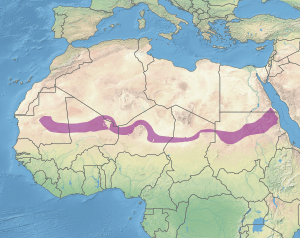South Saharan steppe and woodlands
The South Saharan steppe and woodlands, also known as the South Sahara desert, is a deserts and xeric shrublands ecoregion of northern Africa.
| South Saharan steppe and woodlands | |
|---|---|
 map of the South Saharan steppe and woodlands | |
| Ecology | |
| Realm | Palearctic |
| Biome | Deserts and xeric shrublands |
| Geography | |
| Area | 1,101,700 km2 (425,400 sq mi) |
| Countries | |
| Conservation | |
| Conservation status | relatively intact |
The ecoregion covers 1,101,700 square kilometers (425,400 sq mi) in Algeria, Chad, Mali, Mauritania, Niger, and Sudan. It extends east and west across the continent in a band, forming a transition between the hyper-arid Sahara Desert to the north and the Sahel grasslands and savannas to the south.
Movements of the equatorial Intertropical Convergence Zone (ITCZ) bring summer rains during July and August which average 100 to 200 mm, but vary greatly from year to year. These rains sustain summer pastures of grasses and herbs, with dry woodlands and shrublands along seasonal watercourses.[1]
Niger's Aïr and Ténéré Addax Sanctuary Aïr and Ténéré National Nature Reserve include a portion of the ecoregion.
Ecoregion delineation
In 2001, WWF devised Terrestrial Ecoregions of the World (TEOW) "a biogeographic regionalization of the Earth's terrestrial biodiversity".[2] The 2001 regionalization divided the deserts of the Sahara into several ecoregions. The South Saharan steppe and woodlands ecoregion included the transitional region between the Sahelian Acacia savanna and the Sahara's hyper-arid center, designated the Sahara desert ecoregion.[3][4]
In 2017, the authors of the 2001 system proposed a revised ecoregion system for the Sahara. The South Saharan steppe and woodlands ecoregion was extended into the central Sahara, and renamed South Sahara desert. Two new ecoregions, the West Sahara desert and East Sahara desert, were designated in the hyper-arid center.[5]
References
- "South Saharan steppe and woodlands". Terrestrial Ecoregions. World Wildlife Fund. Retrieved December 29, 2007.
- "Terrestrial Ecoregions of the World". World Wildlife Fund. Accessed 25 April 2020.
- "South Saharan steppe and woodlands". Terrestrial Ecoregions. World Wildlife Fund. Retrieved April 25, 2020.
- Olson, D. M., Dinerstein, E., Wikramanayake, E. D., Burgess, N. D., Powell, G. V. N., Underwood, E. C., D'Amico, J. A., Itoua, I., Strand, H. E., Morrison, J. C., Loucks, C. J., Allnutt, T. F., Ricketts, T. H., Kura, Y., Lamoreux, J. F., Wettengel, W. W., Hedao, P., Kassem, K. R. 2001. Terrestrial ecoregions of the world: a new map of life on Earth. Bioscience 51(11):933-938.
- Eric Dinerstein, David Olson, et al. (2017). An Ecoregion-Based Approach to Protecting Half the Terrestrial Realm, BioScience, Volume 67, Issue 6, June 2017, Pages 534–545,